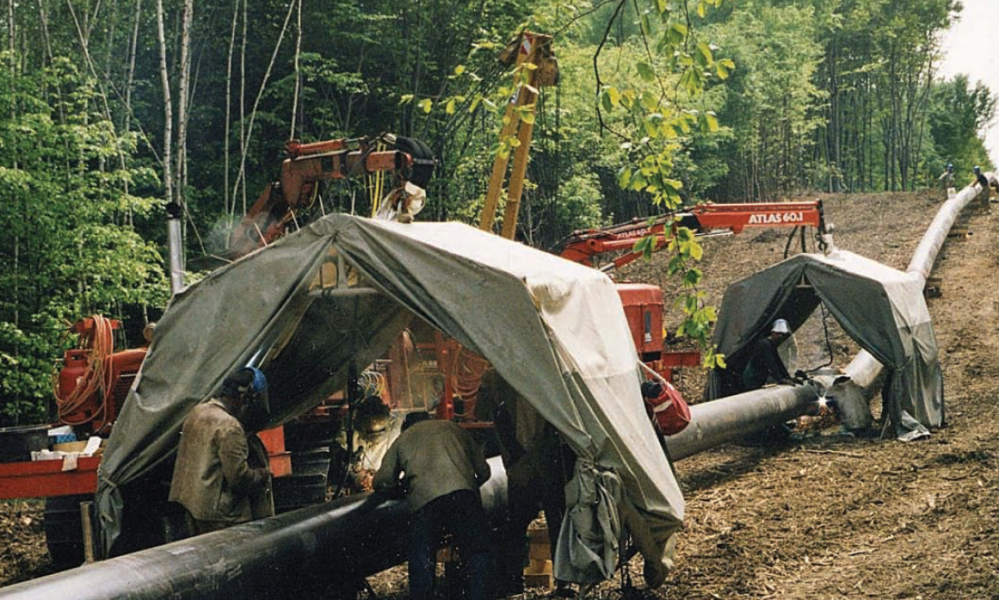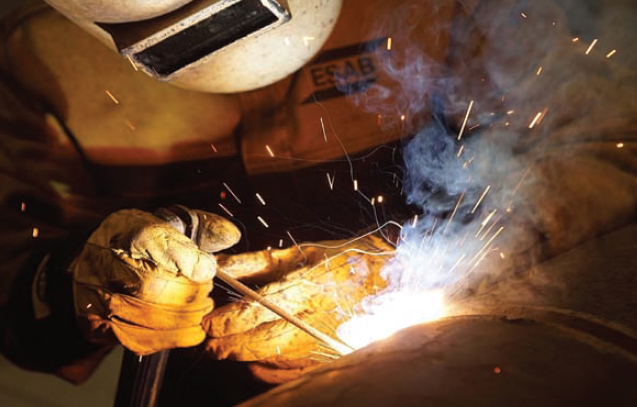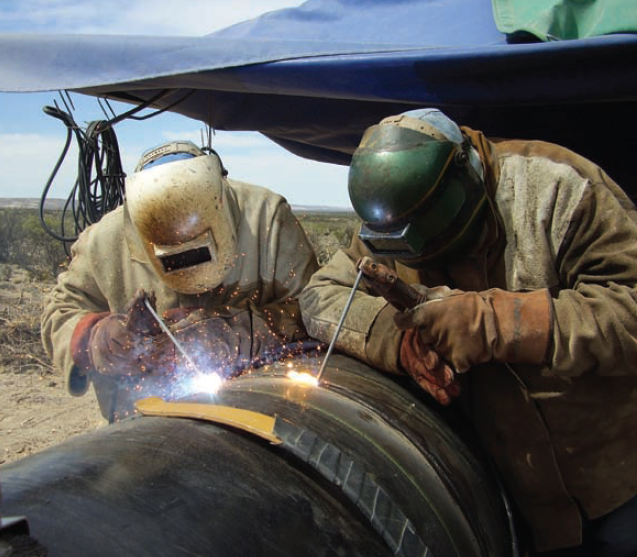- FMA
- The Fabricator
- FABTECH
- Canadian Metalworking
Pipe welding: Anywhere, anytime
Pipe welding in the field is clean and efficient
- By Nestor Gula
- July 8, 2014
- Article
- Fabricating
Those that have not seen what modern pipe welding is all about have an image of this endeavour that is truly prehistoric. The image is of rusted pipes scattered haphazardly about the field as burly men weld pipe by hand with cigarettes clamped between their teeth.
This image makes a great movie but doesn’t reflect today’s world. “Pipeline welding operators often face rigorous environments, where weather and wind can be factors. Machines used for pipe welding in the field must be durable, reliable and designed to stand up to the sometimes very harsh conditions,” said Jim Byrne, Manager – Application/Sales Group for Pipe Welding Products at Miller Electric Mfg. Co. “The processes and equipment also need to provide welding operators with the flexibility to work on expansive job sites (e.g. via remote welding controls) and the ability to consistently produce high quality welds that stand up to code requirements. Individual steps to creating a successful weld include (among others), good weld joint preparation, proper filler metal storage, proper adherence to weld parameter and proper welding operator training. These practices are equally important to creating quality welds on pipe in a fabrication setting.”
We most associate the term pipeline with carrying crude oil. “Pipelines are used to transport may things: water, natural gas, crude oil, gasoline and solids in a slurry solution to name but a few,” said Bruce Clark, Director, Marketing and Export Sales for Lincoln Electric Canada. “The materials that pipeline are made of range from plastic to high-yield steel, aluminium, stainless steel and special varieties of stainless steel like Duplex and Super Duplex. The level of quality required for the pipe itself and the welded joint depends on the type of product being piped and the governing body responsible for the safety of the finished line. Suffice to say when transporting products like natural gas, or crude oil a great deal of attention is paid to the soundness of the welds and can require 100% of the welds to be x-rayed. In order to assure successful welds and zero to low repair rates pipelines require all welders to be prequalified before the job starts and from then on they must follow the welding procedures to the letter. To make sure they do there is always a quality control team on site that follows the progress of the pipe from start to finish.”
FIT UP IS CRITICAL
Although pipe that are used to build lines may have the same nominal diameter, they are not all the same. No pipe is round and no pipe is the same the saying goes. “In the manufacturing process, they will most likely use submerged arc welding to join the seam after the pipe has been rolled,” said Nick Drake, Marketing Manager at Gullco International. “A larger pipe has to be produced that way. You will not find a large pipe that has been extruded and has no seam at all, when you are dealing with pipelines. Because of that process, and submerged arc welding, you get a lot of heat and warpage. This results in inaccuracy in the pipe fit-up in the field.” Due to this minor variance matching up and placing the first welds is a complex and skilled endeavour. “It becomes very difficult to automate the root pass, which is the initial weld that brings the two pieces of pipe together. That either gets done by MIG, which is a wire fed welding process, or by stick electrodes. There are some automated carriages that can lay the root but they are very expensive and the pipe set-up has to be very accurate. So when you get out to the field that becomes less and less possible and therefore you lay the root by hand and the subsequent welds can be automated,” said Drake.
CLEAN THE JOINTS
Like all welding, a clean joint is essential in pipeline welding. The image of rusty pipes lying in a field is from a bygone era. Most of the time a pipe is delivered to the site covered with a coating that covers the pipe from manufacturing, during transportation and to the final delivery. “The pipe can be as rusty as anything in the middle it just cannot have rust on the joint,” said Drake.
“Joint cleanliness is critical for producing-defect free welds and at a minimum the pipe ends will be cleaned mechanically with abrasive wheels immediately prior to welding,” said Gordon Eadie, Global Pipeline Segment Manager for ESAB Welding & Cutting Products. For some larger projects the procedure is more advanced than a simple grind with an angle grinder. “First of all you have to be able to create the proper welding temperature by preheating for the type of steel that you are using,” said Jack Wallin, Product Manager for Stoody. “If you are outside and you are making a pipeline and it is raining than you better have something that will cover you from the wind and the elements. Then you must clean the deposits by grinding the surface to make sure that you are free of all contaminants such as hydrogen, moisture left on the pipe, hydrocarbons such as oil on the pipe, and rust. You need a clean joint to start with.”
One only has to look at the controversy surrounding the XL pipeline proposal to know that there are great environmental concerns over pipelines. Pipeline construction is subject to rigorous testing by various federal agencies. “Clean joints are extremely important because you won’t get the weld to pass the test if the joint has corrosion or moisture rust in the joint,” said Drake. “A clean joint is imperative to having the weld pass the test that is needed so that work can move on. They do one of two things. They preheat very often to extremely high temperatures, as much a upwards of 400 degrees Fahrenheit. That helps get rid of all the moisture and that also affects the fit-up because any time you are transferring heat into the material you can cause warpage and can cause the fit up to change again.
Every single weld joint will get X-rayed. They will strap a track on and then an X-ray camera that will run around the weld and they will be able to see any defect that might exist.
A clean joint when welding reduces the chance of porosity and a bad weld. “Porosity is always present to one extent or another, but there are rules based on scientific studies that state how much and where porosity is acceptable,” said Clark. “Porosity can be avoided by following a number of simple rules. Follow the electrode manufacturers guidelines for the care and storage of the welding electrodes, and if they are exposed to moisture, again follow the manufacturer’s recommendations for re-drying them.
Although porosity can occur when welding, it is a defect that often can be easily addressed. “Some common causes of porosity include the presence of moisture on the weld metal; contaminants such as dirt or oil on the material surface; nozzles plugged with spatter; and excess shielding gas levels,” said Jim Byrne, Manager – Application/Sales Group for Pipe Welding Products at Miller Electric Mfg. Co. “Some tips for preventing these issues are: preheating the material to evaporate moisture and proper storage of filler metals to prevent them from becoming damp; cleaning the surface prior to welding to remove impurities; clearing plugged nozzles of spatter; protecting the shielding gas from airflow or drafts that may disturb it and adjusting gas flow so it’s not too high. On the code quality welds required on pipeline applications, porosity can cause failure of x-ray testing, leading to costly and time-consuming rework. In many cases, the downtime for such rework could lead to missed deadlines or potential fines for delays.”
Besides protecting the weld itself, when MIG welding one must ensure that the shielding gas is not blown away. “All welds are protected from the elements (wind and rain) as loss of shielding gas for wire processes or water ingress into the arc area can potentially result in weld defects,” said Eadie. “All surface breaking porosity would be classed as a defect and should be removed / repaired. Porosity can also increase the risk of cracks due to changes in cross section. Porosity is a permissible defect provided it is within the limits detailed in the applicable acceptance criteria.
AUTOMATION FOR THE PIPELINE
Although there is still a lot of hand-held welding being done in the pipeline industry, automation is taking hold. “New technologies available in some machines designed for field and fabrication shop applications make advanced welding processes easier to use in pipe welding than ever before, though proper training and maintenance remain important,” said Byrne. “Some modified short circuit MIG processes precisely monitor and control the arc with advanced software, which results in a calm, controllable puddle. Such processes are well suited to produce code quality work for the root pass in pipe welding, to help improve productivity and reduce rework. Some available pulsed MIG and modified short circuit MIG processes can monitor and adjust parameters up to 20,000 times per second to maintain optimum arc conditions. Quick process changeover between available options also helps with productivity in the shop. Some systems in the market even provide push button weld process selection and eliminate the need to swap cables, which helps increase arc time while also accommodating various weld procedures and weld pass progressions.”
Automated pipeline welding has its own complications since a pipe is round and you cannot rotate it to maintain an optimal welding position. “The use of welding “bugs” is on the increase and many regions now have very little in the way of manually welded pipelines,” said Eadie. “Also, the use of AUT (automatic ultrasonic testing) that historically was only used on off-shore pipelines is now more common on land-based pipelines.” These “bugs” are tracked control units that hold the tip for the wire in the proper position and can even control the weld parameters. “The carriage we designed has a wire feeder integrated with the carriage so that eliminates part of the transportation as you move from joint to joint,” said Drake. “It will hold a 12 pound spool of wire which is generally enough to do an 8-hour shift. It is remote control where the welder adjusts the voltage, the wire speed and the carriage speed using the remote as the carriage moves around the pipe.” These carriages are not a fire and forget solution as you still need an operator to monitor the arc. “You start upside down and move from 6 o’clock to 12 o’clock position. Usually they will use two carriages and they will stagger them at the start so that they do both sides at the same time. This also helps to reduce the amount of warpage in the pipe as you are applying the arc to both sides simultaneously,” he said.
With higher and tighter criteria, manual pipeline welding is falling out of favour because they “cannot achieve the required acceptance criteria. “For field applications, remote control technologies available in some systems also allow the welding operator to adjust parameters with the touch of a button and have point-of-use control (without a control cable) up to 200 feet from the power source, increasing safety and productivity and preventing the welding operator from settling for less than optimal welding parameters,” said Byrne.
[gallery columns="1" type="slideshow" ids="103831,103832,103833"]
About the Author
subscribe now


Keep up to date with the latest news, events, and technology for all things metal from our pair of monthly magazines written specifically for Canadian manufacturers!
Start Your Free Subscription- Trending Articles
Class is in session for college connections
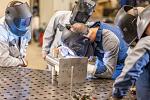
Engine-driven welding machines include integrated air compressors

BlueForge Alliance partners with Nuts, Bolts & Thingamajigs to develop Submarine Manufacturing Camps

Orbital tube welding webinar to be held April 23

Corrosion-inhibiting coating can be peeled off after use
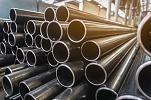
- Industry Events
ZEISS Quality Innovation Days 2024
- April 15 - 19, 2024
Tube 2024
- April 15 - 19, 2024
- Düsseldorf, Germany
CTMA Economic Uncertainty: Helping You Navigate Windsor Seminar
- April 30, 2024
- Windsor, ON Canada
MME Winnipeg
- April 30, 2024
- Winnipeg, ON Canada
CTMA Economic Uncertainty: Helping You Navigate Kitchener Seminar
- May 2, 2024
- Kitchener, ON Canada













